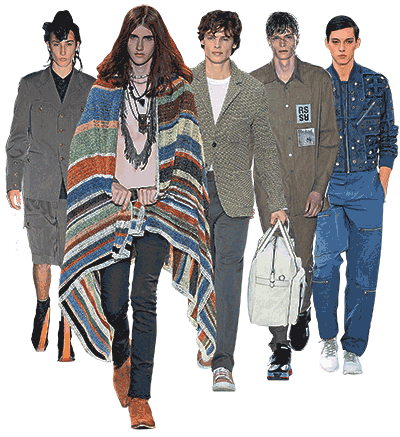Paris spring/summer 2015 menswear shows
Simply sign up to the Life & Arts myFT Digest -- delivered directly to your inbox.
At the Paris menswear shows for spring/summer 2015, barely anyone used the word “luxury”. For many seasons, luxury has been so fashionable that many have confused “luxury” and “fashion” as the same thing. They’re not. Maybe it’s because these were spring/summer shows, giving brands less chance to use heavily luxuriant fabrics. Except that doesn’t hold, since many of the shows featured coats and jackets, accepting the reality that these clothes will start entering stores in January 2015. Could it be that luxury and fashion are decoupling?
The work of Hedi Slimane at Saint Laurent could have something to do with this. His hard, fast and uncompromising shows are far removed from the luxury norm, where the audience is coddled to feel like this could be their idealised life. At Saint Laurent, young men hurl themselves down the catwalk in clothes you could imagine them actually wearing, including leather jackets, skinny jeans and blazers.
Saint Laurent makes an immediate fashion connection that doesn’t need to bother itself with trappings of luxury. It is Slimane’s eye for garments with a cultish air that creates such a strong force.

His fashion is also making extraordinary profit for the luxury conglomerate Kering, redefining the way a brand creates a spark in the 21st century. Saint Laurent leaves many in the industry bemused. Poor them.
Of course, there are still brands that rightly engage in luxury. It is a word that sits easily on the lips of Kim Jones, whose work at Louis Vuitton involves indulgences for the sake of it. Most interesting here were trousers that sat high and wide, like many seen this season, and an excellent nylon bomber in either loud orange or more chief executive-on-vacation-friendly navy.
At Berluti, creative director Alessandro Sartori has recognised its surprise big sellers are luxury sportswear pieces, rather than the raffish tailoring with which he started at the brand a couple of years ago. Cue leather blousons, safari jackets and a leather trainer made by the same artisans who create the brand’s famous shoes. Meanwhile, at Hermès, the air of ease was assured, from its lightweight tailoring in a shade called sand, to its soft, wide shorts that sat just above the knee.
From these Paris shows, however, what sticks in the mind is fashion. Raf Simons showed extraordinary work that combined personal memory with images that cause a subconscious jolt. Most of the action took place at the back, where sailors’ flaps on coats and jackets were printed with old photos of Simons’s parents, collaged with Japanese script, scenes from Jaws, and oil rigs either functioning or as burning scenes of disaster. This was clothing as an honest means of expression.
At Comme des Garçons, fashion was used to ridicule the trappings of war. Military jackets were spliced with strips of cloth such as leopard print, or daubed with slogans including “movement for the liberation from stupid war”.
Winkle-picker shoes curled up to an extreme point, pushing the military caricature to the realm of purposeful grotesque. Rare in fashion, it was a genuine stand.
There is so much to mention. The indigo-dyed shades were delicious in Junya Watanabe’s collection, based on Japanese tradition. I was also greatly taken by the floral prints at Valentino. Paul Smith staged the best collection I’ve seen by him, with a convincing mix of soft satin suits and fun off-kilter pop imagery created for Smith by Fergus Purcell.
Dries Van Noten’s float-away soft coats and dancer pants had youth and energy; also looking to dance was Rick Owens, whose interpretation was more visceral, especially denim rompers and shorts with wide bands of cloth that wrapped up and under. Haider Ackermann continued to excel with a lush layering of herringbones, florals and optical squares.
There was an abundance of fashion, but not everywhere. Givenchy makes a mint from menswear, but its floral prints and polo shirts felt one-note. Dior Homme, meanwhile, doesn’t know if it’s luxury or fashion so currently feels like neither. It should look to LVMH stablemate Loewe, where Jonathan Anderson made the debut of the season.
He immediately defined a modern world for the luxury fashion brand, from the desirability of denim trousers with a wide white cuff, to its covetable array of blankets. Yes, blankets, apparently among the brand’s biggest sellers in the 1940s, since discontinued.
Fashion may be thriving in Paris but sometimes all that’s desired is to curl up and be cosseted, which is a fine luxury in itself.
Photographs: Catwalking
Comments